Visit your favourite destinations |
| A Report from birdtours.co.uk |
Mongolia, August 12th to August 21st 2005,
Introduction:
After a very successful trip to Mongolia in 2001, we decided to go again, this time with our respective spouses who lucked out last time. The party was made up of my parents, Ralf and Juliane, my wife Ha, and yours truly.
Just like with our last visit, we used Selena Travel, they can be reached at www.selenatravel.com. Once again, everything was pretty well organized, apart from a couple of minor glitches; more on that further down.
As only my wife and myself are birders, we did not book a hard-core birding trip. However, Mongolia is all about nature (not many cinemas and discotheques in the Gobi), so birding was possible everywhere.
Logistics and prices:
As we were flying in from three different continents, we decided to meet in Beijing. We also had not yet secured our visas, as there is no Consulate in Ho Chi Minh City, where I live, and no Embassy in Kenya, from where my father came in. We had to obtain express visas, they cost USD 50.00 for us Westerners, but only USD 4.50 for my Vietnamese wife!
The actual trip was USD 1,020.00 per person, and included all transport, food, and accommodation in Mongolia. Drinks were extra, but I found them reasonably prized, considering the distances involved to cart in the booze: USD 2.00 to USD 3.00 for beer (APU makes two excellent beers, "Gobi" and "Golden Gobi"), Tea was free and plentiful, and soft drinks around USD 1.00. If you are like my mom and insist on drinking wine in the middle of nowhere, expect to pay USD 20.00+ per bottle.
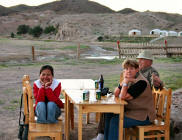 |
Dinner in the Gobi |
Accommodation and food:
We gave Ulaan Bator a miss, it has to be one of the ugliest cities I have ever laid eyes on, and headed straight for a Ger camp. With one exception, all the Ger camps were very good, with clean facilities. The tents were large and clean, the same applied to the shared bathroom facilities.
One thing that certainly changed from my last visit was the virtual absence of Mutton. Four years ago, everything tasted of Mutton, even the Toast, this time round the camps had obviously made an effort at "westernizing" their food. Bad for me, as I like Mutton, good for everyone else. Food was generally good, and sometimes outstanding.
Dangers and Annoyances:
People are very friendly everywhere. They are good-natured, helpful and very curious about foreigners, in particular if they lug enough optics to sink a battleship. Nevertheless, interaction was somewhat limited as not many people spoke English.
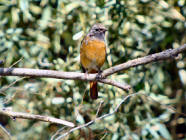 |
Daurian Redstart |
Beware of the dogs!!!!! Some of them are huge, and they tend to be very protective of their Gers. I always gave Gers a wide berth, in the open country side, they left us alone.
I would probably advise against driving yourself. Although it is legally possible, it is not very practical. Outside Ulaan Bator, there are no road signs (and not many roads), the dirt tracks look all the same, petrol stations are few and far in between, and forget about asking for directions due to the afore mentioned language difficulties.
We all had the runs at one stage or another (Dshinghis Khan's revenge), some medication might be a good thing to pack.
Distance are enormous, or rather the bad roads make a 300 km trip last 6-7 hours. Maybe not the best thing for small kids.
A last word on Beijing customs: they are the most paranoid guys i have ever met. My mother had to pour away the Whiskey she was carrying in her hand luggage upon check-in, some other fellow-travelers had to leave a bottle of beer they were carrying. Never mind that you then pass all the Duty Free Shops!
A word on the spelling of location names: there seems to be no hard and fast rule, I have seen Ulaan Bator spelt in half-a-dozen different ways, and that is true for all Mongolian names.
Weather:
August = summer = warm weather, right? Wrong!!!!!!!! Whilst we had mostly good weather, we did have a couple of days when it was literally freezing, with frequent rain. I had learned from my last trip and brought warm clothes, but I still got cold a couple of times.
The Gobi, whilst cool in the morning, was warm during the day. Drink plenty of water, the temperatures combined with humidity of about "zilch" dehydrates you real quick.
Books:
My mom brought the 2005 Lonely Planet Guide for the obligatory traveler look. I had only brought one bird book, McKinnon’s “A Field Guide to the Birds of China." Not a bad book, but a couple of good books on Waders in particular would have come in handy, as McKinnon's book is not very good on those.
Birds:
Many of the birds seen are obviously common in Europe. As I live in Vietnam however, I had a blast with birds like Twite:-) Just wish I knew my waders better. I do not think that August is the best time, as migration had not yet set in. If, and when, I return, I will probably opt for May. I would also not return to the Gobi a second time. Whilst it was spectacular, it got a little bit old in the end, and birds were not very evident. I guess that leaves me the North and West for my next trip.
And a word from the author:
Thanks go to Selena Travel, and in particular Zola who planned the trip, Bebe our guide, the driver, whose name I never could remember, and to all the Mongolians who helped us one way or another.
Very special thanks go to my parents, Juliane and Ralf, for the companionship and as drinking companions, and, of course, my suffering wife Ha. Once again, you held up great with your fanatic husband. Love you!!!!
Finally, all errors and omissions are mine, and mine alone. I can be contacted at hannostamm@hotmail.com.
Itinerary:
12th of August
We had spent a few days in Beijing, where it was extremely hot and humid; I was ready to go. However, just as we were about to take off, a massive thunderstorm rolled in, and we took off with 1.5 hours delay. Anyway, I survived the two-hour flight (in no small thanks to the beers I quaffed to combat my fear of flying) and we met our guide "Bebe" and the driver. The car was a bit of a disappointment, an old, beat-up Toyota van from Korea. However, it would see us through Mongolia, even if it was not always comfortable. We also found out that we were to fly back from the Gobi. Being scared of flying, and having seen the MIAT (Maybe It Arrives Tomorrow) fleet first hand, there was no way! Thus, the program had to be altered a little bit, but that turned out OK in the end.
We had a quick lunch in Ulaan Bator and hit the road for the 150 km to the Steppe Nomads tourist camp. On the way, we saw Common Raven, Black-eared Kites, and about 50 Daurian Jackdaws. The camp is located in Guen Galut Nature Reserve (http://www.argalipark.com/), and was certainly one of the nicer camps we had. The weather was gorgeous, but it was too late to get any more birding in (but did manage to get a few Dshinghis Beers in).
Not much to choose for "bird of the day", so Ha and I settle for Daurian jackdaw.
13th of August
The good thing about birding in Mongolia is that there is no need to get up real early, there is no light until 07:00. By that time, I was chafing at the bit, but the first bird I saw was Grey Heron. Obviously, I was more pleased at the 50+ Red-billed Choughs that came wheeling in overhead. The Isabelline Wheatears were the first of hundreds, if not thousands seen during the trip, whilst the Mongolian Ground-Jay was a lot rarer. The first two Demoiselle Cranes made an appearance (the Cranes actually provided the morning wake-up call), and the only Bar-headed Geese of the entire trip flew by. I managed to get a few photos of a male Horned Lark, and saw the first waders in the shape of Common Sandpiper and Little Ringed Plover.
My wife finally got out of bed, and we walked towards where one of the waitresses had spotted more Cranes through an antique Chinese scope. As usual in Mongolia, the walk turned into a real slog; the clear air makes it very difficult to judge distances. The first Cranes we saw were more Demoiselle Cranes, this time with juveniles. We pushed on, and a good thing it was, too: the other two cranes where White-naped Cranes. Apart from being the first lifer of the trip, the fact that there are only about 5,000 of those gorgeous birds left made this a real find.
Thus buoyed, and after a good breakfast, we drove to Lake Ikh guen, a few kilometers away. The shores and the lake itself were pretty busy with birds, and Great Crested Grebe, Ruddy Shelduck, Northern Shoveler, Common Shelduck, Black-tailed Godwit, Wood Sandpiper, and Common Goldeneye were all quickly notched up. Just before heading back for lunch, a Saker Falcon obliged with excellent views.
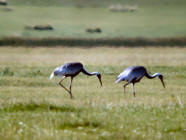 |
White-naped Cranes |
After lunch, we headed to Lake Ayaya. By now, the wind had picked up to the extent that I had to hold on to my scope. The birds were seeking shelter wherever they could, and behind a small dune, we found a whole flock of Citrine Wagtails. The Northern Lapwings did not seem to like the gale much either, whilst the 4 Swan Geese were unimpressed. The single Hoopoe seemed out of place in the cold, whilst the Eastern Marsh Harrier continued hunting, flushing a flock of Common Teal in the process.
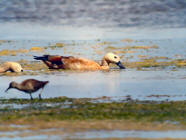 |
Ruddy Shelduck |
After dinner, just before it got dark, a Common Kestrel hovered briefly in front of the restaurant.
Bird of the day for both of us was, without a doubt, the White-naped Cranes.
14th of August
We had an early start today, as we needed to cover 400 km to Mongol Els on "paved" roads (some of the dirt roads later during the trip were better than this "highway").
We stopped for lunch at Hustai National Park. Actually, one look at this back-packer ghetto, and at the food, and I went birding instead. Whilst my parents and Ha drove off to look at the Takhi wild horses, I added a beautiful male Amur Falcon to my list.
We arrived at the Hoyor Zagal Camp just in time for some last-minute birding. By now, it had gotten really cold, with freezing rain. I just managed to see Eurasian Swallow and 5 Black-winged Stilts before the rain drove me back. The camp was OK, if crowded, we had to eat in shifts.
Bird of the day for me was the Amur Falcon, Ha did not really bird today.
15th of August
Once again, I could not get my wife out of bed, so I went birding around a couple of small lakes near the camp. It was bitterly cold and I regretted not having brought gloves. A single Common Snipe was busy poking around in the mud, whilst a Eurasian Hobby almost flew into me. Not much apart from that, little surprise with the atrocious weather conditions.
After breakfast, with my hands functioning again, we drove to Karakorum. Highlight was a Cinereous Vulture feeding on a Camel head by the side of the road.
Karakorum, the ancient capital established by Genghis Khan, is famous for the monastery of Erdenezuu. At least the temples were somewhat warmer. The bird here was House Sparrow. Not a joke, as House Sparrows are not common in my part of the world, and even in Mongolia it would remain the only ones we saw. Much more common were the Eurasian Tree Sparrows.
For lunch, we drove to the Orgoo Camp, where we were also supposed to stay. However, when we saw the camp, we refused to get out of the car. It was a run-down affair, in the middle of a desolate plain, with gale-force winds blowing. No, thank you! The driver than took us to Dreamland Resort, which was very beautifully situated along a river and surrounded by trees. The camp is owned and run by a Mongolian Sumo Wrestler who reached the "Yokozuma" level. Whilst big, he turned out to be a very nice guy.
Anyway, back to the birds. Ha and myself headed straight for the trees, which were full of Daurian Redstarts, Black-billed Magpies, and Red-backed Shrikes. A single Eurasian Wryneck gave very good views whilst taking a dust bath. Warblers were thin on the ground, with only Arctic Warbler making an appearance, whilst Flycatchers were present in the form of Spotted and Red-throated Flycatcher. White Wagtails and Common Tern were present along the river.
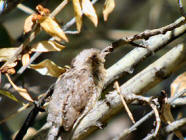 |
Wryneck |
After an excellent Mongolian Dinner it was off to bed, luckily the Gers were heated.
Bird of the day for Ha was House Sparrow (lifer for her), I'll settle for the Wryneck.
16th of August
A quick spin before breakfast added to more birds to the list, White-backed Woodpecker and Eurasian Collared Dove.
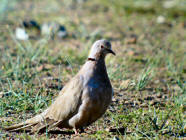 |
Eurasian Collared Dove |
Off to the Gobi. On the way to the Great Gobi Tourist Camp, we saw a single Mongolian Lark.
The Great Gobi Tourist Camp had some of the best food on the trip. The only downside was that there are only two toilets and two showers for about 30 Gers. But then, I do not mind bird watching dirty, and set off. Before hitting the desert, I released a single Dusky Warbler which had flown into the restaurant and couldn't get out.
There was not much birdlife about, apart from the common Desert Wheatears and Rufous-tailed Shrikes. A bonus were 7 Hill Pigeons perched in a tree.
Enjoying the once again warm and sunny weather, we retreated to good food and lots of cold ones.
Bird of the day for both of us was White-backed Woodpecker.
17th of August
Apart from a single Little Ringed Plover, there were virtually no birds, and we set off to the Bayanzag Ger Camp further into the Gobi and, more importantly for me, haunt of the Saxaul Sparrow. Not much to see during the drive, apart from magnificent landscape, and a lone Northern Wheatear.
Once at the camp, Ha and myself headed straight for the Saxaul Forest. Forest is actually a bit of a misnomer, shrub would be more like it. The place was dead except for a Brown Shrike, a Fox and a couple of Hares. Dejected, we headed back to the camp, when a small flock of birds flew into the shrub near us. Panic! But the birds had settled, and good views through the scope confirmed 8 Saxaul Sparrows. Success!!!!
Unanimous decision again: Saxaul Sparrow takes the honors.
18th of August
Off to the Gurvansai Khan National Park. A Saker Falcon flew along the car for a little while, whilst three Pallas' Sandgrouse fed along the road.
My parents headed for the gorge that the Park is famous for, Ha and myself opted to bird around a small stream. Small Snowfinch were everywhere, and absolutely tame. A Cinereous Vulture made the most of the first updrafts, whilst Eurasian Crag Martins were whizzing about. Another lifer for me came in the form of a very smart Brown Accentor, for Ha it was a Yellow-breasted Bunting. It took me ages to get to grips with three Twite, guess I have been away from Europe too long:-( The Black Redstart was much easier, as was the huge Lammergeyer flying above, looked like a wardrobe! Midday Gerbils were busy collecting food for the winter everywhere, whilst the Marmots just lazed about in the sun.
After a long and exciting day, we headed back to the Great Gobi Tourist Camp where we had a good dinner in their turtle-shaped restaurant.
Bird of the day for Ha was Yellow-breasted Bunting, I'll take the Brown Accentor, thank you very much.
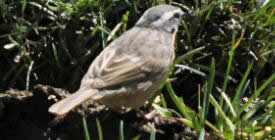 |
Brown Accentor |
19th of August
A long drive to the Middle Gobi Camp, the worst camp of the all. Apart from the fact that it was run-down, dirty, and with lousy food, they had no drinks!!! No water, soft drinks or beer!!!! Avoid at all costs. Only the birds somewhat made up for it. I trekked to a couple of largish lakes about three kilometers away. The low grass was full of Greater Short-toed Larks and Blyth's Pipits, the lakes had Black-headed Gulls, White-winged Black Terns, Pacific Golden Plover, Common Greenshank, and Spotted Redshank. The 16 Ruddy Shelducks looked out of place in the middle of the Gobi.
Once again, it was only me birding, so I chose the Larks.
20th of August
A really long haul today, all the way to Molor Juulchin Camp in Terelj National Park where we would spend the last night in Mongolia. No time for birding and we only added a Common Buzzard to the list.
The consolation was the camp, which was extremely well placed, very clean, with great food and cold beer.
Let us not talk about bird of the day
21st of August
Last day in Mongolia, sniff. Before we had to head back for our flight, I explored the camp surroundings and added two Pine Buntings, two Olive-backed Pipits, and a handful of Willow Tits to the list.
Bird of the day: Pine Bunting.All in all, I saw 86 species (plus another 9 in China). Some might not be much to the European reader, but it sure made a change from my usual tropical haunts. And some birds were fantastic (White-naped Crane: need I say more?).

List of species seen:
(* = lifer)
1. |
Whooper Swan |
Cygnus cygnus |
2. |
Swan Goose * |
Anser cygnoides |
3. |
Bar-headed Goose |
Anser indicus |
4. |
Ruddy Shelduck |
Tadorna ferruginea |
5. |
Common Shelduck |
Tadorna tadorna |
6. |
Northern Shoveler |
Anas clypeata |
7. |
Northern Pintail |
Anas acuta |
8. |
Common Teal |
Anas crecca |
9. |
Tufted Duck |
Aythya fuligula |
10. |
Common Goldeneye |
Bucephala clangula |
11. |
Eurasian Wryneck |
Jynx torquilla |
12. |
White-backed Woodpecker * |
Dendrocopos leucotos |
13. |
Eurasian Hoopoe |
Upupa epops |
14. |
Hill Pigeon * |
Columba rupestris |
15. |
Eurasian Collared-dove |
Streptopelia decaocto |
16. |
White-naped Crane * |
Grus vipio |
17. |
Demoiselle Crane |
Grus virgo |
18. |
Pallas's Sandgrouse * |
Syrrhaptes paradoxus |
19. |
Common Snipe |
Gallinago gallinago |
20. |
Black-tailed Godwit |
Limosa limosa |
21. |
Eurasian Curlew |
Numenius arquata |
22. |
Spotted Redshank |
Tringa erythropus |
23. |
Common Greenshank |
Tringa nebularia |
24. |
Wood Sandpiper |
Tringa glareola |
25. |
Common Sandpiper |
Tringa hypoleucos |
26. |
Ruddy Turnstone |
Arenaria interpres |
27. |
Red-necked Stint |
Calidris ruficollis |
28. |
Curlew Sandpiper |
Calidris ferruginea |
29. |
Black-winged Stilt |
Himantopus himantopus |
30. |
Pacific Golden-plover |
Pluvialis fulva |
31. |
Little Ringed Plover |
Charadrius dubius |
32. |
Northern Lapwing |
Vanellus vanellus |
33. |
Herring Gull |
Larus argentatus |
34. |
Black-headed Gull |
Larus ridibundus |
35. |
Common Tern |
Sterna hirundo |
36. |
White-winged Tern |
Chlidonias leucopterus |
37. |
Black-eared Kite |
Milvus lineatus |
38. |
Lammergeier |
Gypaetus barba |
39. |
Cinereous Vulture |
Aegypius monac |
40. |
Eastern Marsh-harrier |
Circus spilonotus |
41. |
Common Buzzard |
Buteo buteo |
42. |
Upland Buzzard |
Buteo hemilasius |
43. |
Common Kestrel |
Falco tinnunculus |
44. |
Amur Falcon * |
Falco amurensis |
45. |
Eurasian Hobby |
Falco subbuteo |
46. |
Saker Falcon |
Falco cherrug |
47. |
Great Crested Grebe |
Podiceps cristatus |
48. |
Horned Grebe |
Podiceps auritus |
49. |
Grey Heron |
Ardea cinerea |
50. |
Red-backed Shrike |
Lanius collurio |
51. |
Rufous-tailed Shrike |
Lanius isabellinus |
52. |
Brown Shrike |
Lanius cristatus |
53. |
Eurasian Magpie |
Pica pica |
54. |
Mongolian Ground-jay * |
Podoces hendersoni |
55. |
Red-billed Chough |
Pyrrhocorax pyrrhocorax |
56. |
Daurian Jackdaw |
Corvus dauuricus |
57. |
Common Raven |
Corvus corax |
58. |
Spotted Flycatcher |
Muscicapa striata |
59. |
Red-throated Flycatcher |
Ficedula parva albicilla |
60. |
Daurian Redstart |
Phoenicurus auroreus |
61. |
Northern Wheatear |
Oenanthe oenanthe |
62. |
Desert Wheatear |
Oenanthe deserti |
63. |
Isabelline Wheatear |
Oenanthe isabellina |
64. |
Willow Tit |
Parus montanus |
65. |
Sand Martin |
Riparia riparia |
66. |
Eurasian Crag-martin |
Hirundo rupestris |
67. |
Eurasian Swallow |
Hirundo rustica |
68. |
Dusky Warbler |
Phylloscopus fuscatus |
69. |
Arctic Warbler |
Phylloscopus borealis |
70. |
Mongolian Lark |
Melanocorypha mongolica |
71. |
Greater Short-toed Lark |
Calandrella brachydactyla |
72. |
Horned Lark |
Eremophila alpestris |
73. |
Saxaul Sparrow * |
Passer ammodendri |
74. |
House Sparrow |
Passer domesticus |
75. |
Eurasian Tree Sparrow |
Passer montanus |
76. |
Small Snowfinch |
Montifringilla davidiana |
77. |
White Wagtail |
Motacilla alba |
78. |
Citrine Wagtail |
Motacilla citreola |
79. |
Grey Wagtail |
Motacilla cinerea |
80. |
Blyth's Pipit * |
Anthus godlewskii |
81. |
Olive-backed Pipit |
Anthus hodgsoni |
82. |
Red-throated Pipit |
Anthus cervinus |
83. |
Brown Accentor * |
Prunella fulvescens |
84. |
Twite * |
Carduelis flavirostris |
85. |
Pine Bunting |
Emberiza leucocephalos |
86. |
Yellow-breasted Bunting |
Emberiza aureola |
Full Version of report with pictures
http://www.pass4-sure.us/4A0-100-dumps.html
http://www.mybraindumps.net/70-649.html
http://www.arm.com/
http://www.test-king.com/exams/HP2-K38.htm
http://www.actualtests.com/exam-VCPVCD510.htm
Why not send us a report, or an update to one of your current reports?